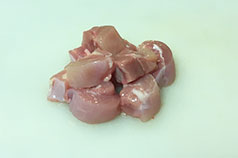
Boneless Chicken Thigh
Chicken thigh is upper part of the leg, and is used to cook variety of dishes all over the world. Since it is dark colored meat, it has more flavor, and it remains juicy and tender when cooked on high heat or slow cooked. Chicken thigh can be used in many ways to prepare dishes. These can be roasted, grilled, sauteed, pan-fried, baked or curried.
Chicken thigh has more muscle and fat - 4 ounces of boneless and skinless chicken thigh has 69% protein, 31% fat, and 0% carbohydrates. Both dark and white chicken meat is a good source of proteins, vitamins A, K, B6, B12, folate, niacin, and minerals such as iron, selenium, phosphorus, and zinc.
Buy chicken with USDA organic seal to make sure that the chicken is raised on food that does not contain animal by-products and is not raised with antibiotics.
Chicken thigh has more muscle and fat - 4 ounces of boneless and skinless chicken thigh has 69% protein, 31% fat, and 0% carbohydrates. Both dark and white chicken meat is a good source of proteins, vitamins A, K, B6, B12, folate, niacin, and minerals such as iron, selenium, phosphorus, and zinc.
Buy chicken with USDA organic seal to make sure that the chicken is raised on food that does not contain animal by-products and is not raised with antibiotics.
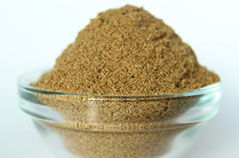
Cumin Powder
Native to the Mediterranean regions and northern Africa, cumin has been cultivated for thousands of years in the Middle East, India, China and the Mediterranean. Cumin is one of the most consumed spices in the world.
Cumin is a drought tolerant and grows best in warm, dry climates. Ideal temperatures for growing cumin is between 77°F to 86°F. Depending on the location, cumin has a growing season of 3 to 4 months. The plant produces small white or pink flowers and dark green seed pods. The seeds are harvested when the plant starts to wilt and the seed pods changes from dark green to brownish yellow.
India has been the largest producer of cumin with around 75% of the total crop produced, followed by Syria, Turkey, Iran, and China.
Cumin is used to in various curry powders and spice blends to flavor dishes in India, Middle East, Mexico, Portugal, and Spain. Cumin adds nutty and spicy taste to the grilled meat, soups and stews, sausages, pickles, and rice and bean dishes. It is also used to make liqueur - an alcoholic drink consumed after meal. Oil of cumin is used in fragrances.
Cumin can be used as whole seed or in powdered form that are easily available in grocery stores or can be made at home by grinding the cumin seeds. To make cumin powder at home:
In addition to adding flavor to the dishes, cumin helps in digestion and digestive problems. The essential oil in cumin activates the salivary glands in mouth that helps in primary digestion of food. The presence of essential oil, sodium, and magnesium in cumin provides relief from stomach aches. The essential oil in cumin also relieves stress and anxiety and helps inducing sleep. Presence of caffeine in combination with essential oil loosen up and eliminate mucus and phlegm in respiratory tract, which help to heal the initial condition leading to respiratory disorders such as asthma.
Cumin seeds last for about an year whereas cumin powder lasts for about six months at room temperature. Store the cumin seeds or powder in a tight lid jar in a cool, dark, and dry place. If you do not use it often in your cooking then keep the seeds or powder in the freezer to last up to 2 years.
Cumin powder is available in Indian and South Asian grocery stores. Some of the popular brands of cumin powder are Nirav, Deep, SWAD, Spicy World, and Jiva. You may also find it in supermarkets or gourmet markets. It is also available at online grocery stores such as amazon.com, where you will be able to choose from several brands.
Cumin is a drought tolerant and grows best in warm, dry climates. Ideal temperatures for growing cumin is between 77°F to 86°F. Depending on the location, cumin has a growing season of 3 to 4 months. The plant produces small white or pink flowers and dark green seed pods. The seeds are harvested when the plant starts to wilt and the seed pods changes from dark green to brownish yellow.
India has been the largest producer of cumin with around 75% of the total crop produced, followed by Syria, Turkey, Iran, and China.
Cumin is used to in various curry powders and spice blends to flavor dishes in India, Middle East, Mexico, Portugal, and Spain. Cumin adds nutty and spicy taste to the grilled meat, soups and stews, sausages, pickles, and rice and bean dishes. It is also used to make liqueur - an alcoholic drink consumed after meal. Oil of cumin is used in fragrances.
Cumin can be used as whole seed or in powdered form that are easily available in grocery stores or can be made at home by grinding the cumin seeds. To make cumin powder at home:
- Either dry the cumin seeds in sun for a couple of days or slightly roast the seeds without oil in a pan. Roasting the seeds before grinding enhances the taste and aroma of the coriander powder. Also, drying in sun or roasting removes moisture from the seeds and adds crispness, which helps in powdering the seeds.
- Let the seeds cool and then grind them in a spice grinder. You can also use a coffee grinder for grinding spices; however it’s not recommended to use the same grinder for grinding spices and coffee.
- Store cumin powder in a tightly sealed container in a cool, dark, and dry place. If you are making cumin powder at home, cool it down before storing. It usually last for 4-6 months at room temperature. Refrigerate it for a longer shelf life of 18-24 months.
In addition to adding flavor to the dishes, cumin helps in digestion and digestive problems. The essential oil in cumin activates the salivary glands in mouth that helps in primary digestion of food. The presence of essential oil, sodium, and magnesium in cumin provides relief from stomach aches. The essential oil in cumin also relieves stress and anxiety and helps inducing sleep. Presence of caffeine in combination with essential oil loosen up and eliminate mucus and phlegm in respiratory tract, which help to heal the initial condition leading to respiratory disorders such as asthma.
Cumin seeds last for about an year whereas cumin powder lasts for about six months at room temperature. Store the cumin seeds or powder in a tight lid jar in a cool, dark, and dry place. If you do not use it often in your cooking then keep the seeds or powder in the freezer to last up to 2 years.
Cumin powder is available in Indian and South Asian grocery stores. Some of the popular brands of cumin powder are Nirav, Deep, SWAD, Spicy World, and Jiva. You may also find it in supermarkets or gourmet markets. It is also available at online grocery stores such as amazon.com, where you will be able to choose from several brands.
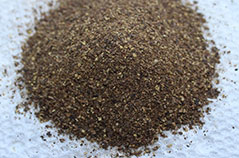
Black Pepper Powder

Garlic
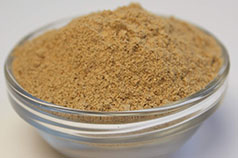
Cinnamon Powder

Lime Juice
Lime juice or juice extracted from lime is a great source of vitamin C and used to add tartness and freshness to food and beverages. It also a natural preservative and slows down the spoilage of food. The juice is squeezed from fresh cut lime or bought readymade at grocery stores or supermarkets.
Best quality lime is bright deep green in color and is firm and heavy for its size. More ripen lime turn yellow in color; however it is best when green. Lime produces more juice when warmer. Therefore, to get the most juice out of lime, bring it to room temperature (if refrigerated) and roll it under your palm against a hard surface to warm it more, before squeezing. Another quick method is to microwave it for 15-30 seconds, let it sit for a few minutes before cutting and squeezing.
In addition to its use in food and drinks, lime juice also provides health benefits that include weight loss, skin care, and improved digestion. Due to the presence of significant amount of vitamin C, it helps in curing scurvy, which is caused due to vitamin C deficiency. Vitamin C in lime juice also acts as an antioxidant and helps in strengthening the immune system.
Lime or packaged lime juice is available in grocery stores throughout the year. Lime will stay fresh for a week at room temperature when kept away from sunlight. You can also store it in your refrigerator’s crisper tray for about a month, if bought fresh.
Best quality lime is bright deep green in color and is firm and heavy for its size. More ripen lime turn yellow in color; however it is best when green. Lime produces more juice when warmer. Therefore, to get the most juice out of lime, bring it to room temperature (if refrigerated) and roll it under your palm against a hard surface to warm it more, before squeezing. Another quick method is to microwave it for 15-30 seconds, let it sit for a few minutes before cutting and squeezing.
In addition to its use in food and drinks, lime juice also provides health benefits that include weight loss, skin care, and improved digestion. Due to the presence of significant amount of vitamin C, it helps in curing scurvy, which is caused due to vitamin C deficiency. Vitamin C in lime juice also acts as an antioxidant and helps in strengthening the immune system.
Lime or packaged lime juice is available in grocery stores throughout the year. Lime will stay fresh for a week at room temperature when kept away from sunlight. You can also store it in your refrigerator’s crisper tray for about a month, if bought fresh.
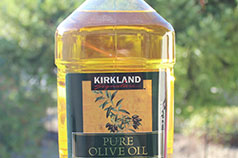
Olive Oil
Olive is one of the oldest known cultivated trees in the world. It is said that Olive trees are being cultivated before the invention of written language. Olive trees are draught tolerant and are native to eastern Mediterranean region. The trees can survive and bear fruits for a thousand year. Olives are small fruits of the Olive tree. During prehistoric time, people use to grind and drain the pulp of olives to get oil for cooking and lighting lamps. Oil extracted from olives was also used for cosmetic purposes.
Today, olive oil is popular than any other oil for culinary use and health benefits. About 90% of the olive fruit produce goes toward the production of olive oil. The oil is produced by pressing the whole olives and is used for cooking, cosmetics, pharmaceutical uses, and as fuel for certain lamps.
Olive oil used for cooking and eating is broadly classified as extra virgin, virgin, pure, and light. The difference is mainly in the process of production of different verities, due to which they contain different levels of antioxidant and have different smoking point.
Extra virgin olive oil is the best quality and is extracted using mechanical process such as cold pressing and centrifugation. The olives are pressed at normal temperature without the use of heating and chemicals. This method of extraction helps preserve most of the antioxidants and hence, makes the oil of high quality. The extra virgin olive oil smokes at a very low temperatures ranging from 200 to 372 degree Fahrenheit depending upon the quality (the better the quality have higher smoking point). Therefore, extra virgin olive oil is considered cold dishes like salad dressing and dips as well as cooking at a medium heat. You can use the good quality extra virgin oil to sauté vegetables, shallow frying eggs, and meats. It’s not recommended to use extra virgin olive oil for deep frying at higher temperatures.
Virgin olive oil is extracted using the same process as extra virgin. It has same levels of monounsaturated fats, antioxidant, and has the similar smoking point. It’s different from extra virgin because it’s made using relatively ripe olives, which gives it light flavor. The usage of virgin oil for cooking is same as extra virgin oil.
Pure olive oil has the same monounsaturated fat content, but has less antioxidant. Pure olive oil, also called olive oil, is a blend of virgin oil and refined pomace oil (also called refined olive oil). Pomace oil, a leftover during the extraction of extra virgin and virgin oils, is refined before mixing it to the virgin oil. The blend contains only about 5 to 10% of virgin oil. It’s lighter in taste, and has higher smoking point that makes it fit for sautéing and frying.
Light olive oil has the same percentage of monounsaturated fat, but lowest level of antioxidants. It’s basically refined olive oil, manufactured by the using some chemical and heat to get rid of impurities. It’s smoking point is highest and is ideal for high temperature cooking, such as deep frying and baking.
At higher temperatures, required for deep frying, extra virgin and virgin oil lose their antioxidant properties and flavor. Therefore, many cooks use pure or light olive oil for frying. Some views suggest that cooking with extra virgin and virgin olive oil at high temperatures is harmful for health; however, there is no substantial evidence to support such views. This might be a myth or a truth. Therefore, to be on the safe side, it’s advisable to use pure and light olive oil for higher temperature cooking such as deep frying, and use good quality extra virgin and virgin olive oil for cold dishes and cooking at medium temperature such as sautéing.
Because of the higher monounsaturated fat content, all kinds of olive oil lasts longer than other oils. After opening, close the cap or lid completely and store in a cool, dark, and dry place, and use it within 3 – 4 months from opening. Due to the presence of antioxidant substances, extra virgin and virgin oils are more resistant to damage by oxygen in air. However, the chlorophyll in the oil makes them vulnerable to damage by light. Therefore, always store the extra virgin and virgin oil in a dark place away from light. Refrigeration slightly solidifies the oil, which comes back to its liquid state when kept at room temperature, but will lose its flavor.
Olive oil has high content of antioxidants called polyphenols, carotenoids, and tocopherols. It’s high in monounsaturated fat and has low saturated and polyunsaturated fat. This composition makes it healthy for heart and for prevention of many medical conditions like, cancer, high blood pressure, and diabetes. According to some recent research, consumption of olive oil improves calcium absorption; hence, prevents the onset osteoporosis.
You can buy olive oil at any grocery store. It is available at online grocery stores such as www.amazon.com. Type the kind of olive oil you want to buy on search bar, you will be able to choose from several options.
Today, olive oil is popular than any other oil for culinary use and health benefits. About 90% of the olive fruit produce goes toward the production of olive oil. The oil is produced by pressing the whole olives and is used for cooking, cosmetics, pharmaceutical uses, and as fuel for certain lamps.
Olive oil used for cooking and eating is broadly classified as extra virgin, virgin, pure, and light. The difference is mainly in the process of production of different verities, due to which they contain different levels of antioxidant and have different smoking point.
Extra virgin olive oil is the best quality and is extracted using mechanical process such as cold pressing and centrifugation. The olives are pressed at normal temperature without the use of heating and chemicals. This method of extraction helps preserve most of the antioxidants and hence, makes the oil of high quality. The extra virgin olive oil smokes at a very low temperatures ranging from 200 to 372 degree Fahrenheit depending upon the quality (the better the quality have higher smoking point). Therefore, extra virgin olive oil is considered cold dishes like salad dressing and dips as well as cooking at a medium heat. You can use the good quality extra virgin oil to sauté vegetables, shallow frying eggs, and meats. It’s not recommended to use extra virgin olive oil for deep frying at higher temperatures.
Virgin olive oil is extracted using the same process as extra virgin. It has same levels of monounsaturated fats, antioxidant, and has the similar smoking point. It’s different from extra virgin because it’s made using relatively ripe olives, which gives it light flavor. The usage of virgin oil for cooking is same as extra virgin oil.
Pure olive oil has the same monounsaturated fat content, but has less antioxidant. Pure olive oil, also called olive oil, is a blend of virgin oil and refined pomace oil (also called refined olive oil). Pomace oil, a leftover during the extraction of extra virgin and virgin oils, is refined before mixing it to the virgin oil. The blend contains only about 5 to 10% of virgin oil. It’s lighter in taste, and has higher smoking point that makes it fit for sautéing and frying.
Light olive oil has the same percentage of monounsaturated fat, but lowest level of antioxidants. It’s basically refined olive oil, manufactured by the using some chemical and heat to get rid of impurities. It’s smoking point is highest and is ideal for high temperature cooking, such as deep frying and baking.
At higher temperatures, required for deep frying, extra virgin and virgin oil lose their antioxidant properties and flavor. Therefore, many cooks use pure or light olive oil for frying. Some views suggest that cooking with extra virgin and virgin olive oil at high temperatures is harmful for health; however, there is no substantial evidence to support such views. This might be a myth or a truth. Therefore, to be on the safe side, it’s advisable to use pure and light olive oil for higher temperature cooking such as deep frying, and use good quality extra virgin and virgin olive oil for cold dishes and cooking at medium temperature such as sautéing.
Because of the higher monounsaturated fat content, all kinds of olive oil lasts longer than other oils. After opening, close the cap or lid completely and store in a cool, dark, and dry place, and use it within 3 – 4 months from opening. Due to the presence of antioxidant substances, extra virgin and virgin oils are more resistant to damage by oxygen in air. However, the chlorophyll in the oil makes them vulnerable to damage by light. Therefore, always store the extra virgin and virgin oil in a dark place away from light. Refrigeration slightly solidifies the oil, which comes back to its liquid state when kept at room temperature, but will lose its flavor.
Olive oil has high content of antioxidants called polyphenols, carotenoids, and tocopherols. It’s high in monounsaturated fat and has low saturated and polyunsaturated fat. This composition makes it healthy for heart and for prevention of many medical conditions like, cancer, high blood pressure, and diabetes. According to some recent research, consumption of olive oil improves calcium absorption; hence, prevents the onset osteoporosis.
You can buy olive oil at any grocery store. It is available at online grocery stores such as www.amazon.com. Type the kind of olive oil you want to buy on search bar, you will be able to choose from several options.

Paprika
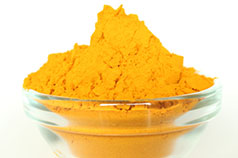
Turmeric Powder
Turmeric powder is a bright and deep yellow colored powder made by grinding dried underground stems of turmeric, which is starchy in nature. In India and some of its neighboring countries, turmeric in stem or powdered form has been used to color skin and clothing and to add color and aroma to food. It is also used as a pious powder during festivals and marriage ceremonies. In other parts of the world, turmeric is mainly used to add color and aroma to food. Turmeric has pungent and bitter taste but musky and mild fragrance.
Turmeric powder is made by steaming or boiling the underground stems in slightly alkaline water (measures above 7.0 on the pH scale) to precook the starch in turmeric. The alkaline water also improves the color of turmeric. Boiled turmeric stems are sun-dried and ground to make powder.
Turmeric powder is mainly used in curries, stir fried dishes, and dry rubs. It is also used in some spicy salad dressing and smoothies and drinks.
The compound called curcuminoids in turmeric is responsible for its yellow color and has antioxidant and preservative properties. Due to its antioxidant properties, use of turmeric in food helps prevent certain type of cancer, lowers cholesterol, lowers the risk of cardiovascular diseases, and protects from Alzheimer’s disease. Due to its preservative property, use of turmeric in food helps in extending the shelf-life of food.
Turmeric has also been used in Indian and Chinese system of medicine as an anti-inflammatory agent to treat various conditions such as toothache, bruises, chest pain, and digestion problems. In addition, turmeric contains very good amounts of minerals like iron, calcium, potassium, manganese, zinc, copper, and magnesium.
Store turmeric powder in a tightly sealed container in a cool, dark, and dry place. At room temperature, turmeric powder will taste fresh for 4 to 6 months. Refrigerate it for a longer shelf-life of up to 2 years.
Turmeric powder is available in Indian and South Asian grocery stores. Some of the popular brands of turmeric powder are Nirav, Deep, SWAD, Spicy World, and Jiva. You may also find it in supermarkets or gourmet markets. It is available at online grocery stores such as amazon.com, where you will be able to choose from several brands.
Turmeric powder is made by steaming or boiling the underground stems in slightly alkaline water (measures above 7.0 on the pH scale) to precook the starch in turmeric. The alkaline water also improves the color of turmeric. Boiled turmeric stems are sun-dried and ground to make powder.
Turmeric powder is mainly used in curries, stir fried dishes, and dry rubs. It is also used in some spicy salad dressing and smoothies and drinks.
The compound called curcuminoids in turmeric is responsible for its yellow color and has antioxidant and preservative properties. Due to its antioxidant properties, use of turmeric in food helps prevent certain type of cancer, lowers cholesterol, lowers the risk of cardiovascular diseases, and protects from Alzheimer’s disease. Due to its preservative property, use of turmeric in food helps in extending the shelf-life of food.
Turmeric has also been used in Indian and Chinese system of medicine as an anti-inflammatory agent to treat various conditions such as toothache, bruises, chest pain, and digestion problems. In addition, turmeric contains very good amounts of minerals like iron, calcium, potassium, manganese, zinc, copper, and magnesium.
Store turmeric powder in a tightly sealed container in a cool, dark, and dry place. At room temperature, turmeric powder will taste fresh for 4 to 6 months. Refrigerate it for a longer shelf-life of up to 2 years.
Turmeric powder is available in Indian and South Asian grocery stores. Some of the popular brands of turmeric powder are Nirav, Deep, SWAD, Spicy World, and Jiva. You may also find it in supermarkets or gourmet markets. It is available at online grocery stores such as amazon.com, where you will be able to choose from several brands.

Ginger
Native to Southeastern Asia, Ginger is popularly used as a spice and medicine in both eastern and western cultures. Ginger was used by ancient Romans and later, after the fall of Roman Empire, was traded in Europe by Arabs who took over the spice trade. Ginger became very expensive like other spices, and in medieval times, was traded in preserved form to make sweet treats.
For many years, ginger has been used to flavor a wide variety of food, from meats and sausages to fish and vegetables, and various curries as well as drinks and desserts. Fresh ginger can be used as sliced, crushed, or as paste.
Ginger has antioxidant and anti-inflammatory properties; therefore, it’s used in traditional medicine to cure a variety of ailments, such as, gastrointestinal distress, motion sickness, arthritis, and cold and flu. Cooking food with small quantity of ginger on a regular basis also adds to health benefits.
The distinct flavor and medicinal property of ginger comes from gingerols, shogaols, and zingerone. Fresh ginger contains gingerol an anti-inflammatory compound that is believed to help in reducing osteoarthritis or rheumatoid arthritis pain, if consumed on a regular basis. It may also prevent growth of certain cancer. Gingerol is transformed into shogaols when dried and cooked. Also, when ginger is cooked gingerol and shogaols is transformed into zingerone. Due to the presence of zingerone, food cooked with ginger has a sweet and spicy flavor. The anti-inflammatory and antioxidant properties of zingerone help in prevention and cure of many medical problems. Dry ginger alone has strong flavor due to shogaols used in many medicines as well as compliments cookies, cakes, and candies recipes, and tea and drinks.
In addition to the use for culinary and medicinal purposes, ginger is also used to fragrance many soaps and cosmetics.
Ginger is sold in many forms in supermarkets, such as fresh, dried, powdered, preserved, crystallized, and as oil. You will find ginger paste, a popular way of using ginger to make curries in Asian countries, in Asian and South Asian grocery stores. Be sure to use ginger in the recipe in the form it’s advised. For example, if a recipe calls for fresh ginger, it cannot be replaced with dry or powdered or other types. Each form of ginger has a distinct taste and different purpose.
Ginger is best stored as whole and unpeeled in a sealed plastic bag in refrigerator. If part of the ginger has been cut or peeled, be sure to dry it before storing. Other forms of ginger are mainly packaged and need to be stored as per instructions by the seller.
For many years, ginger has been used to flavor a wide variety of food, from meats and sausages to fish and vegetables, and various curries as well as drinks and desserts. Fresh ginger can be used as sliced, crushed, or as paste.
Ginger has antioxidant and anti-inflammatory properties; therefore, it’s used in traditional medicine to cure a variety of ailments, such as, gastrointestinal distress, motion sickness, arthritis, and cold and flu. Cooking food with small quantity of ginger on a regular basis also adds to health benefits.
The distinct flavor and medicinal property of ginger comes from gingerols, shogaols, and zingerone. Fresh ginger contains gingerol an anti-inflammatory compound that is believed to help in reducing osteoarthritis or rheumatoid arthritis pain, if consumed on a regular basis. It may also prevent growth of certain cancer. Gingerol is transformed into shogaols when dried and cooked. Also, when ginger is cooked gingerol and shogaols is transformed into zingerone. Due to the presence of zingerone, food cooked with ginger has a sweet and spicy flavor. The anti-inflammatory and antioxidant properties of zingerone help in prevention and cure of many medical problems. Dry ginger alone has strong flavor due to shogaols used in many medicines as well as compliments cookies, cakes, and candies recipes, and tea and drinks.
In addition to the use for culinary and medicinal purposes, ginger is also used to fragrance many soaps and cosmetics.
Ginger is sold in many forms in supermarkets, such as fresh, dried, powdered, preserved, crystallized, and as oil. You will find ginger paste, a popular way of using ginger to make curries in Asian countries, in Asian and South Asian grocery stores. Be sure to use ginger in the recipe in the form it’s advised. For example, if a recipe calls for fresh ginger, it cannot be replaced with dry or powdered or other types. Each form of ginger has a distinct taste and different purpose.
Ginger is best stored as whole and unpeeled in a sealed plastic bag in refrigerator. If part of the ginger has been cut or peeled, be sure to dry it before storing. Other forms of ginger are mainly packaged and need to be stored as per instructions by the seller.

Cayenne
Share your thoughts and questions!


